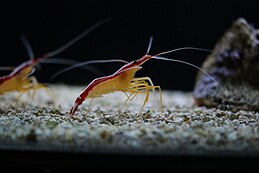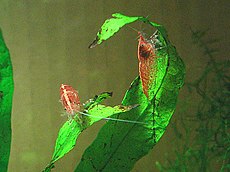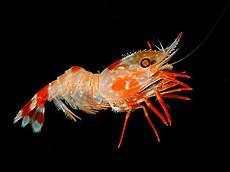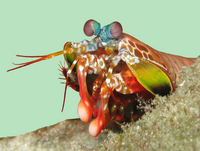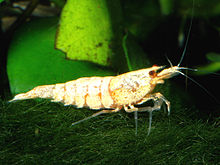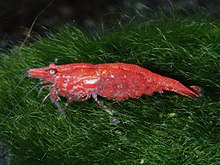Shrimp

Ashrimp(pl.:shrimp (US) or shrimps (UK) is acrustacean(a form ofshellfish) with an elongated body and a primarily swimming mode of locomotion – typically belonging to theCarideaorDendrobranchiataof the orderDecapoda,although somecrustaceans outside of this orderare also referred to as "shrimp".
More narrow definitions may be restricted to Caridea, to smaller species of either group or to only the marine species. Under a broader definition,shrimpmay be synonymous withprawn,covering stalk-eyed swimmingcrustaceanswith long, narrow muscular tails (abdomens), long whiskers (antennae), and slender legs.[1]Any small crustacean which resembles a shrimp tends to be called one.[2]They swim forward by paddling withswimmeretson the underside of their abdomens, although their escape response is typically repeated flicks with the tail driving them backwards very quickly.Crabsandlobstershave strong walking legs, whereas shrimp have thin, fragile legs which they use primarily for perching.[3]
Shrimp are widespread and abundant. There are thousands of species adapted to a wide range of habitats. They can be found feeding near the seafloor on most coasts and estuaries, as well as in rivers and lakes. To escape predators, some species flip off the seafloor and dive into the sediment.[3]They usually live from one to seven years.[4]Shrimp are often solitary, though they can form largeschoolsduring the spawning season.[3][5]
They play important roles in thefood chainand are an important food source for larger animals ranging fromfishtowhales.The muscular tails of many shrimp are edible to humans, and they are widely caught and farmed for human consumption. Commercial shrimp species support an industry worth 50 billion dollars a year,[3]and in 2010 the total commercial production of shrimp was nearly 7 million tonnes. Shrimp farming became more prevalent during the 1980s, particularly in China, and by 2007 the harvest from shrimp farms exceeded the capture of wild shrimp. There are significant issues with excessivebycatchwhen shrimp are captured in the wild, and with pollution damage done toestuarieswhen they are used to support shrimp farming.
Many shrimp species are small as the termshrimpsuggests, about 2 cm (0.79 in) long, but some shrimp exceed 25 cm (9.8 in). Larger shrimp are more likely to be targeted commercially and are often referred to asprawns,particularly in theCommonwealth of Nationsand former British colonies.
Classification
From Raymond Bauer inRemarkable Shrimps:[6]
- Shrimpis characteristically used to refer to those crustaceans with long antennae, slender legs, and a laterally compressed, muscular abdomen that is highly adapted for both forward swimming and a backward (retrograde) escape response.
- Prawnis often used as a synonym ofshrimpforpenaeoideanandcaridean shrimp,especially those of large size.
From the English Oxford Dictionaries:
Shrimp are swimmingcrustaceanswith long narrow muscularabdomensand longantennae.Unlike crabs and lobsters, shrimp have well developedpleopods(swimmerets) and slender walking legs; they are more adapted for swimming than walking. Historically, it was the distinction between walking and swimming that formed the primary taxonomic division into the former subordersNatantiaandReptantia.Members of the Natantia (shrimp in the broader sense) were adapted for swimming while the Reptantia (crabs, lobsters, etc.) were adapted for crawling or walking.[9]Some other groups also have common names that include the word "shrimp";[10]any small swimming crustacean resembling a shrimp tends to be called one.[3]
| Differences between shrimp, lobsters and crabs | ||
|---|---|---|
| Shrimp are slender with long muscular abdomens. They look somewhat like small lobsters, but not like crabs. Theabdomensof crabs are small and short, whereas the abdomens of lobsters and shrimp are large and long. The lower abdomens of shrimp support pleopods which are well-adapted for swimming. Thecarapacesof crabs are wide and flat, whereas the carapaces of lobsters and shrimp are more cylindrical. Theantennaeof crabs are short, whereas the antennae of lobsters and shrimp are usually long, reaching more than twice the body length in some shrimp species.[3][10][11][12] | Clawed lobsters(pictured left)andspiny lobsters(pictured right)are an intermediate evolutionary development between shrimp and crabs. They look somewhat like large versions of shrimp. Clawed lobsters have large claws while spiny lobsters do not, having instead spiny antennae and carapace. Some of the biggest decapods are lobsters. Like crabs, lobsters have robust legs and are highly adapted for walking on the seafloor, though they do not walk sideways. Some species have rudimentary pleopods, which give them some ability to swim, and like shrimp they canlobsterwith their tail to escape predators, but their primary mode of locomotion is walking, not swimming.[3][10][11][13] | Crabsevolved from early shrimp, though they do not look like shrimp. Unlike shrimp, theirabdomensare small, and they have shortantennaeand shortcarapacesthat are wide and flat. They have prominent graspingclawsas their front pair of limbs. Crabs are adapted for walking on the seafloor. They have robust legs and usually move about the seafloor by walking sideways. They have pleopods, but they use them asintromittent organsor to hold egg broods, not for swimming. Whereas shrimp and lobsters escape predators bylobstering,crabs cling to the seafloor and burrow into sediment. Compared to shrimp and lobsters, the carapaces of crabs are particularly heavy, hard andmineralized.[3][10][11][14][15] |
Description
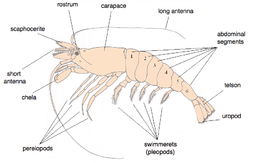

The following description refers mainly to the external anatomy of the common European shrimp,Crangon crangon,as a typical example of a decapod shrimp. The body of the shrimp is divided into two main parts: the head and thorax which are fused together to form thecephalothorax,and a long narrowabdomen.The shell which protects the cephalothorax is harder and thicker than the shell elsewhere on the shrimp and is called thecarapace.The carapace typically surrounds thegills,through which water is pumped by the action of the mouthparts.[16]The rostrum, eyes, whiskers and legs also issue from the carapace. Therostrum,from the Latinrōstrummeaningbeak,looks like a beak or pointed nose at the front of the shrimp's head. It is a rigid forward extension of the carapace and can be used for attack or defense. It may also stabilize the shrimp when it swims backward. Two bulbouseyes on stalkssit either side of the rostrum. These arecompound eyeswhich have panoramic vision and are very good at detecting movement. Two pairs of whiskers (antennae) also issue from the head. One of these pairs is very long and can be twice the length of the shrimp, while the other pair is quite short. The antennae have sensors on them which allow the shrimp to feel where they touch, and also allow them to "smell" or "taste" things bysampling the chemicalsin the water. The long antennae help the shrimp orient itself with regard to its immediate surroundings, while the short antennae help assess the suitability of prey.[3][10]
Eight pairs of appendages issue from the cephalothorax. The first three pairs, themaxillipeds,Latin for "jaw feet", are used asmouthparts.InCrangon crangon,the first pair, themaxillula,pumps water into thegillcavity. After the maxilliped come five more pairs of appendages, thepereiopods.These form the ten decapod legs. InCrangon crangon,the first two pairs of pereiopods have claws orchela.The chela can grasp food items and bring them to the mouth. They can also be used for fighting and grooming. The remaining four legs are long and slender, and are used for walking or perching.[3][10][12][17]
The muscular abdomen has six segments and has a thinner shell than the carapace. Each segment has a separate overlapping shell, which can be transparent. The first five segments each have a pair of appendages on the underside, which are shaped like paddles and are used for swimming forward. The appendages are calledpleopodsor swimmerets, and can be used for purposes other than swimming. Some shrimp species use them for brooding eggs, others have gills on them for breathing, and the males in some species use the first pair or two for insemination. The sixth segment terminates in thetelsonflanked by two pairs of appendages called theuropods.The uropods allow the shrimp to swim backward, and function like rudders, steering the shrimp when it swims forward. Together, the telson and uropods form a splayed tail fan. If a shrimp is alarmed, it can flex its tail fan in a rapid movement. This results in a backward dart called thecaridoid escape reaction(lobstering).[3][10][12]
Habitat
Shrimp are widespread, and can be found near the seafloor of most coasts and estuaries, as well as in rivers and lakes. There are numerous species, and usually there is a species adapted to any particular habitat.[3]Most shrimp species are marine, although about a quarter of the described species are found infresh water.[18]Marine species are found at depths of up to 5,000 metres (16,000 ft),[16]and from the tropics to the polar regions. Although shrimp are almost entirely fully aquatic, the two species ofMerguiaaresemi-terrestrialand spend a significant part of their life on land inmangrove.[19][20]
Behaviour
There are many variations in the ways different types of shrimp look and behave. Even within the core group ofcaridean shrimp,the small delicatePederson's shrimp(above) looks and behaves quite unlike the large commercialpink shrimpor the snappingpistol shrimp.[12]The caridean family of pistol shrimp are characterized by big asymmetrical claws, the larger of which can produce a loud snapping sound. The family is diverse and worldwide in distribution, consisting of about 600 species.[22]Colonies of snapping shrimp are a major source of noise in the ocean and can interfere with sonar and underwater communication.[23][24][25]The smallemperor shrimphas asymbioticrelationship withsea slugsandsea cucumbers,and may help keep them clear of ectoparasites.[26]
Most shrimp areomnivorous,but some are specialised for particular modes of feeding. Some arefilter feeders,using theirsetose(bristly) legs as a sieve; some scrapealgaefrom rocks.Cleaner shrimpfeed on the parasites andnecrotic tissueof the reef fish they groom.[16]Some species of shrimp are known to cannibalize others as well if other food sources are not readily available. In turn, shrimp are eaten by various animals, particularly fish and seabirds, and frequently hostbopyridparasites.[16]
Mating
Females of the freshwater shrimpCaridina ensiferaare capable of storing sperm from multiple partners, and thus can produce progeny with different paternities.[27]Reproductive success of sires was found to correlate inversely with their genetic relatedness to the mother.[27]This finding suggests that sperm competition and/or pre- and post-copulatory female choice occurs. Female choice may increase the fitness of progeny by reducinginbreeding depressionthat ordinarily results from the expression ofhomozygousdeleterious recessive mutations.[28]
Species
Decapods
There is little agreement among taxonomists concerning thephylogenyof crustaceans.[29]Within the decapods, "every study gives totally different results. Nor do even one of these studies match any of the rival morphology studies".[30]Some taxonomists identify shrimp with the infraorderCarideaandprawnswith the suborderDendrobranchiata.[31]While different experts give different answers, there is no disagreement that the caridean species are shrimp.[3]There are over 3000 caridean species.[32]Occasionally they are referred to as "true shrimp".[33]
Traditionally,decapodswere divided into two suborders: theNatantia(or swimmers) and theReptantia(or walkers). The Natantia or swimmers included the shrimp. They were defined by their abdomen which, together with its appendages was well adapted for swimming. The Reptantia or walkers included the crabs and lobsters. These species have small abdominal appendages, but robust legs well adapted for walking. The Natantia was thought to beparaphyletic;that is, it was thought that originally all decapods were like shrimp.[34]
However, classifications are now based onclades,and the paraphyletic suborder Natantia has been discontinued. "On this basis, taxonomic classifications now divide the order Decapoda into the two suborders: Dendrobranchiata for the largest shrimp clade, and Pleocyemata for all other decapods. The Pleocyemata are in turn divided into half a dozen infra-orders"[34]
- The taxonomists De Grave and Fransen, 2011, recognise four major groups of shrimp: the suborderDendrobranchiataand the infraordersProcarididea,StenopodideaandCaridea".[35]This group is identical to the traditionalNatantiagroup, and contains decapods only.
- All shrimp of commercial interest belong to the Natantia. TheFAOdetermine the categories and terminology used in the reporting of global fisheries. They define a shrimp as a "decapod crustacean of the suborder Natantia".[36]
- According to the Codex Alimentarius Commission of theFAOandWHO:"The termshrimp(which includes the frequently used termprawn) refers to the species covered by the most recent edition of the FAO listing of shrimp, FAO Species Catalogue, Volume 1,Shrimps and prawns of the world, an annotated catalogue of species of interest to fisheriesFAO Fisheries Synopsis No. 125. "[37]In turn, theSpecies Cataloguesays the highest category it deals with is "the suborder Natantia of the order Crustacea Decapoda to which all shrimps and prawns belong".[38]
| Major shrimp groups of theNatantia | |||||
|---|---|---|---|---|---|
| Order | Suborder | Infraorder | Image | Extant species[32] | Description |
| Decapoda | Dendrobranchiata | 
|
533 | Penaeid shrimp
| |
| Pleocyemata | Caridea | 
|
3438 | The numerous species in this infraorder are known as caridean shrimp, though only a few are commercially important. They are usually small, nocturnal, difficult to find (they burrow in the sediment), and of interest mainly to marine biologists. Caridean shrimp, such as thepink shrimppictured, typically have two pairs of claws. Female carideans attach eggs to their pleopods and brood them there. The secondabdominal segmentoverlaps both the first and the third segment, and the abdomen shows a pronouncedcaridean bend.[3][9][39][40] | |
| Procarididea | 
|
6 | A minorsister groupto the Caridea (immediately above) | ||
| Stenopodidea | 
|
71 | Known asboxer shrimp,the members of this infraorder are oftencleaner shrimp.Their third pair of walking legs (pereiopods) are greatly enlarged. Thebanded coral shrimp(pictured)is popular in aquariums. The Stenopodidea are a much smaller group than the Dendrobranchia and Caridea, and have no commercial importance.[41] | ||
Other decapod crustaceans also called shrimp, are the ghost or mud shrimp belonging to the infra-orderThalassinidea.In Australia they are calledyabbies.[42]Themonophylyof the group is not certain; recent studies have suggested dividing the group into two infraorders, Gebiidea and Axiidea.[35]
Non-decapods
Ashrimpseems to be almost any crustacean that isn't a lobster, barnacle, or crab
–Greg Jensen[3]
A wide variety of non-decapod crustaceans are also commonly referred to as shrimp. This includes thebrine shrimp,clam shrimp,fairy shrimpandtadpole shrimpbelonging to thebranchiopods,thelophogastridan shrimp,opossum shrimpandskeleton shrimpbelonging theMalacostraca;andseed shrimpwhich areostracods.[3]Many of these species look quite unlike the commercial decapod shrimp that are eaten as seafood. For example,skeleton shrimphave short legs and a slender tail like a scorpion tail,fairy shrimpswim upside down with swimming appendages that look like leaves, and the tinyseed shrimphave bivalved carapaces which they can open or close.[12]Krillresemble miniature shrimp, and are sometimes called "krill shrimp".[43][44]
| Other species groups commonly known as shrimp | |||||
|---|---|---|---|---|---|
| Class | Image | Group | Extant species | Description | |
| Branchiopoda | Branchiopodacomes from the Greekbranchiameaning gills, andpousmeaningfeet.[45]They havegillson their feet ormouthparts.[46] | ||||

|
brine shrimp | 8 | Brine shrimp belong to the genusArtemia.They live in inland saltwater lakes in unusually high salinities, which protects them from most predators. They produce eggs, calledcysts,which can be stored in adormantstate for long periods and then hatched on demand. This has led to the extensive use of brine shrimp asfish feedinaquaculture.[47]Brine shrimp are sold as novelty gifts under the marketing nameSea-Monkeys. | ||

|
clam shrimp | 150 | Clam shrimp belong to the groupConchostraca.These freshwater shrimp have a hingedbivalvedcarapace which can open and close. | ||

|
fairy shrimp | 300 | Fairy shrimp belong to the classAnostraca.These 1–10 cm long freshwater or brackish shrimp have no carapace. They swim upside down with their belly uppermost, with swimming appendages that look like leaves. Mostfairy shrimpare herbivores, and eat only the algae in the plankton. Their eggs can survive drought and temperature extremes for years, reviving and hatching after the rain returns.[48] | ||

|
tadpole shrimp | 20 | Tadpole shrimpbelong to the familyNotostraca.Theseliving fossilshave not much changed since theTriassic.They are drought-resistant and can be found preying on fairy shrimp and small fish at the bottom of shallow lakes andtemporary pools.[49]Thelongtail tadpole shrimp(pictured)has three eyes and up to 120 legs withgillson them.[50]It lives for 20–90 days. Different populations can be bisexual,unisexualorhermaphroditic. | ||
| Malacostraca | Malacostracacomes from the Greekmalakósmeaningsoftandóstrakonmeaningshell.[51]The name is misleading, since normally the shell is hard, and is soft only briefly aftermoulting.[52] | ||||

|
Lophogastrida | 56 | These marinepelagicshrimp make up the orderLophogastrida.They mostly inhabit relatively deep pelagic waters throughout the world. Like the relatedopossum shrimp,females lophogastrida carry abrood pouch.[53] | ||
| mantis shrimp | 400 | Mantis shrimp, so called because they resemble apraying mantisand a shrimp, make up the orderStomatopoda.They grow up to 38 cm (15 in) long, and can be vividly coloured. Some have powerful spiked claws which they punch into their prey, stunning, spearing and dismembering them. They have been called "thumb splitters" because of the severe gashes they can inflict if handled carelessly.[54] | |||

|
opossum shrimp | 1,000 | Opossum shrimp belong to the orderMysida.They are called opossum shrimp because the females carry abrood pouch.Usually less than 3 cm long, they are not closely related to caridean or penaeid shrimp. They are widespread in marine waters, and are also found in some brackish and freshwater habitats in the Northern hemisphere. Marine mysids can form largeswarmsand are an important source of food for many fish. Some freshwater mysids are found in groundwater andanchialine caves.[53][55] | ||

|
skeleton shrimp | Skeleton shrimp, sometimes known as ghost shrimp, areamphipods.Their threadlike slender bodies allow them to virtually disappear among fine filaments in seaweed. Males are usually much larger than females.[56][57]For a good account of a specific species, seeCaprella mutica. | |||
| Ostracoda | Ostracodcomes from the Greekóstrakonmeaningshell.In this case, the shells are in two parts, like those ofbivalvesorclams. | ||||

|
seed shrimp | 13,000 | Seed shrimpmake up the classOstracoda.This is a class of numerous small crustacean species which look like seeds, typically about one millimetre (0.04 in) in size. Their carapace looks like a clam shell, with two parts held together by a hinge to allow the shell to open and close. Some marine seed shrimp drift as pelagic plankton, but most live on the sea floor and burrow in the upper sediment layer. There are also freshwater and terrestrial species. The class includes carnivores, herbivores, filter feeders and scavengers.[58] | ||
Somemantis shrimpare a foot long, and have bulging eyes, a flattened tail and formidable claws equipped with clubs or sharp spikes, which it can use to knock out its opponents.[12][54]
Human uses
History
In 1991, archeologists suggested that ancient raised paved areas near the coast inChiapas,Mexico, were platforms used for drying shrimp in the sun, and that adjacent clay hearths were used to dry the shrimp when there was no sun.[60][61]The evidence was circumstantial, because thechitinousshells of shrimp are so thin they degrade rapidly, leaving no fossil remains. In 1985 Quitmyer and others found direct evidence dating back to 600 AD for shrimping off the southeastern coast of North America, by successfully identifying shrimp from the archaeological remains of theirmandibles(jaws).[62][63][64]Clay vessels with shrimp decorations have been found in the ruins ofPompeii.[64]In the 3rd century AD, the Greek authorAthenaeuswrote in his literary work,Deipnosophistae;"... of all fish the daintiest is a young shrimp in fig leaves."[65]
In North America,indigenous peoples of the Americascaptured shrimp and other crustaceans infishing weirsandtrapsmade from branches andSpanish moss,or used nets woven with fibre beaten from plants. At the same time early European settlers, oblivious to the "protein-rich coasts" all about them, starved from lack of protein.[64]In 1735beach seineswere imported from France, andCajunfishermen in Louisiana started catchingwhite shrimpand drying them in the sun, as they still do today.[64]In the mid nineteenth century, Chinese immigrants arrived for theCalifornia Gold Rush,many from thePearl River Deltawhere netting small shrimp had been a tradition for centuries. Some immigrants starting catching shrimp local toSan Francisco Bay,particularly the small inch longCrangon franciscorum.These shrimp burrow into the sand to hide, and can be present in high numbers without appearing to be so. The catch was dried in the sun and was exported to China or sold to the Chinese community in the United States.[64]This was the beginning of the American shrimping industry.Overfishingand pollution from gold mine tailings resulted in the decline of the fishery. It was replaced by a penaeidwhite shrimpfishery on the South Atlantic and Gulf coasts. These shrimp were so abundant that beaches were piled withwindrowsfrom theirmoults.Modern industrial shrimping methods originated in this area.[64]
""For shrimp to develop into one of the world's most popular foods, it took the simultaneous development of theotter trawl... and the internal combustion engine. "[64]Shrimptrawlingcan capture shrimp in huge volumes by dragging a net along the seafloor. Trawling was first recorded in England in 1376, when KingEdward IIIreceived a request that he ban this new and destructive way of fishing.[66]In 1583, the Dutch banned shrimp trawling in estuaries.[67]
In the 1920s, diesel engines were adapted for use in shrimp boats.Power wincheswere connected to the engines, and only small crews were needed to rapidly lift heavy nets on board and empty them. Shrimp boats became larger, faster, and more capable. New fishing grounds could be explored, trawls could be deployed in deeper offshore waters, and shrimp could be tracked and caught round the year, instead of seasonally as in earlier times. Larger boats trawled offshore and smaller boats worked bays and estuaries. By the 1960s, steel and fibreglass hulls further strengthened shrimp boats, so they could trawl heavier nets, and steady advances in electronics, radar, sonar, and GPS resulted in more sophisticated and capable shrimp fleets.[64]
As shrimp fishing methods industrialised, parallel changes were happening in the way shrimp wereprocessed."In the 19th century, sun dried shrimp were largely replaced bycanneries.In the 20th century, the canneries were replaced with freezers. "[64]
In the 1970s, significantshrimp farmingwas initiated, particularly in China. The farming accelerated during the 1980s as the quantity of shrimp demand exceeded the quantity supplied, and as excessivebycatchand threats toendangered sea turtlesbecame associated with trawling for wild shrimp.[64]In 2007, the production of farmed shrimp exceeded the capture of wild shrimp.[59]
Commercial species
Although there are thousands of species of shrimp worldwide, only about 20 of these species are commercially significant. The following table contains the principal commercial shrimp, the seven most harvested species. All of them are decapods; most of them belong to theDendrobranchiataand four of them arepenaeid shrimp.
| Principal commercial shrimp species | ||||||||||||
|---|---|---|---|---|---|---|---|---|---|---|---|---|
| Group | Common name | Scientific name | Description | Max length (mm) | Depth (m) | Habitat | FAO | WoRMS | 2010 production (thousand tonnes) | |||
| wild | farmed | total | ||||||||||
| Dendrobranchiata | Whiteleg shrimp | Litopenaeus vannamei(Boone, 1931) | The most extensively farmed species of shrimp. | 230 | 0–72 | marine, estuarine | [68][69] | [70] | 1 | 2721 | 2722 | |
| Giant tiger prawn | Penaeus monodonFabricius, 1798 | 336 | 0–110 | marine, estuarine | [71][72] | [73] | 210 | 782 | 992 | |||
| Akiami paste shrimp | Acetes japonicusKishinouye, 1905 | Most intensively fished species. They are small with black eyes and red spots on theuropods.[74]Only a small amount is sold fresh, most isdried,salted orfermented.[74] | 30 | shallow | marine | [75][76] | [77] | 574 | 574 | |||
| Southern rough shrimp | Trachysalambria curvirostris(Stimpson, 1860) | Easier to catch at night, and fished only in waters less than 60 m (200 ft) deep.[78]Most of the harvest is landed in China.[79] | 98 | 13–150 | marine | [80][81] | [82] | 294 | 294 | |||
| Fleshy prawn | Fenneropenaeus chinensis(Osbeck, 1765) | Trawled in Asia where it is sold frozen. Exported to Western Europe. Cultured by Japan and South Korea in ponds.[83] | 183 | 90–180 | marine | [83][84] | [85] | 108 | 45 | 153 | ||
| Banana prawn | Fenneropenaeus merguiensis(De Man, 1888) | Typically trawled in the wild and frozen, with most catches made by Indonesia. Commercially important in Australia, Pakistan and the Persian Gulf. Cultured in Indonesia and Thailand. In India it tends to be confused withFenneropenaeus indicus,so its economic status is unclear.[86] | 240 | 10–45 | marine, estuarine | [86][87] | [88] | 93 | 20 | 113 | ||
| Caridea | Northern prawn | Pandalus borealis(Krøyer, 1838) | Widely fished since the early 1900s in Norway, and later in other countries followingJohan Hjort'spractical discoveries of how to locate them. They have a short life which contributes to a variable stock on a yearly basis. They are not considered overfished. | 165 | 20–1380 | marine | [89][90] | [91] | 361 | 361 | ||
| All other species | 1490
|
220
|
1710
| |||||||||
| Combined total | 3129 | 3788 | 6917 | |||||||||
Fishing

Commercial techniques forcatching wild shrimpincludeotter trawls,seinesandshrimp baiting.A system of nets is used whentrawling.Baitedtrapsare common in parts of thePacific Northwest.
Shrimp trawling can result in very highincidental catchrates of non-target species. In 1997, theFAOfound discard rates up to 20 pounds for every pound of shrimp. The world average was 5.7 pounds for every pound of shrimp.[92]Trawl netsin general, and shrimp trawls in particular, have been identified as sources of mortality for species offinfishandcetaceans.[93]Bycatch is often discarded dead or dying by the time it is returned to the sea, and may alter the ecological balance in discarded regions.[94]Worldwide, shrimp trawl fisheries generate about 2% of the world's catch of fish in weight, but result in more than one third of the global bycatch total.
The most extensively fished species are theakiami paste shrimp,thenorthern prawn,thesouthern rough shrimp,and thegiant tiger prawn.Together these four species account for nearly half of the total wild capture. In recent years, the global capture of wild shrimp has been overtaken by the harvest from farmed shrimp.[59]
Farming

A shrimp farm is anaquaculturebusiness for the cultivation of marine shrimp or prawns for human consumption. Commercial shrimp farming began in the 1970s, and production grew steeply, particularly to match the market demands of theUnited States,JapanandWestern Europe.The total global production of farmed shrimp reached more than 1.6 milliontonnesin 2003, representing a value of nearly 9 billionU.S. dollars.About 75% of farmed shrimp are produced inAsia,in particular inChina,Thailand,Indonesia,IndiaandVietnam.The other 25% are produced mainly inLatin America,whereBrazilis the largest producer. By 2016, the largest exporting nation is India, followed by Ecuador, Thailand, Indonesia and China.[95]
As can be seen from the global production chart on the left, significant aquaculture production started slowly in the 1970s and then rapidly expanded during the 1980s. After a lull in growth during the 1990s, due to pathogens, production took off again and by 2007 exceeded the capture from wild fisheries. By 2010, the aquaculture harvest was 3.9 million tonnes, compared to 3.1 million tonnes for the capture of wild shrimp.[59]
In the earlier years of marine shrimp farming the preferred species was the largegiant tiger prawn.This species is reared in circular holding tanks where they think they are in the open ocean, and swim in "never ending migration" around the circumference of the tank.[96]In 2000, global production was 630,984 tonnes, compared to only 146,362 tonnes forwhiteleg shrimp.Subsequently, these positions reversed, and by 2010 the production of giant tiger prawn increased modestly to 781,581 tonnes while whiteleg shrimp rocketed nearly twenty-fold to 2,720,929 tonnes.[59]Thewhiteleg shrimpis currently the dominant species in shrimp farming. It is a moderately large shrimp reaching a total length of 230 mm (9 "), and is particularly suited to farming because it" breeds well in captivity, can be stocked at small sizes, grows fast and at uniform rates, has comparatively low protein requirements... and adapts well to variable environmental conditions. "[97]In China, prawns are cultured along withsea cucumbersand some fish species, inintegrated multi-trophic systems.
The major producer of farmed shrimp is China. Other significant producers are Thailand, Indonesia, India, Vietnam, Brazil, Ecuador and Bangladesh. Most farmed shrimp is exported to the United States, the European Union and Japan,[98]also other Asian markets, including South Korea, Hong Kong, Taiwan and Singapore.[95]
Investigations byThe Guardianin 2014 andThe Associated Pressin 2015 foundhuman rights abuseson fishing boats operated by Thailand. The boats are manned withslaves,and catch shrimp and fish (including fish for the production offishmealwhich is fed to farmed prawns).[99][100]Greenpeacehas challenged the sustainability of tropical shrimp farming practices on the grounds that farming these species "has led to the destruction of vast areas ofmangrovesin several countries [and] over-fishing of juvenile shrimp from the wild to supply farms. "Greenpeace has placed a number of the prominent tropical shrimp species that are farmed commercially on its seafood red list, including thewhiteleg shrimp,Indian prawnandgiant tiger shrimp.[101]
As food
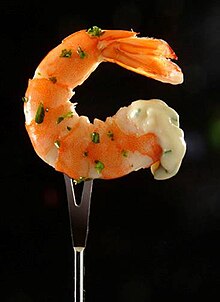
Shrimp aremarketedand commercialized with several issues in mind. Most shrimp are sold frozen and marketed based on their categorization of presentation, grading, colour, and uniformity.[102]Shrimp have high levels ofOmega -3 fatty acidsand low levels ofmercury.[103]Usually shrimp is sold whole, though sometimes only themeat of shrimpis marketed.
As with other seafood, shrimp is high incalcium,iodineandproteinbut low infood energy.A shrimp-based meal is also a significant source ofcholesterol,from 122mgto 251 mg per 100gof shrimp, depending on the method of preparation.[104]Shrimp consumption, however, is considered healthy for the circulatory system because the lack of significant levels of saturated fat in shrimp means that the high cholesterol content in shrimp improves the ratio of LDL to HDL cholesterol and lowerstriglycerides.[105]
Ebiko- shrimproe,sometimes translated as "shrimp flakes" - is used as one of the ingredients in the preparation ofsushi.[106]
Shrimp and othershellfishare among the most commonfood allergens.[107]They are notkosherand thus are forbidden inJewish cuisine.
Aquaria
Several types of shrimp are kept in homeaquaria.Some are purely ornamental, while others are useful in controlling algae and removing debris.[108]Freshwater shrimp commonly available for aquaria include theBamboo shrimp,Japanese marsh shrimp(Caridina multidentata,also called "Amano shrimp," as their use in aquaria was pioneered byTakashi Amano),cherry shrimp(Neocaridina heteropoda), and ghost or glass shrimp (Palaemonetesspp.). Popular saltwater shrimp include the cleaner shrimpLysmata amboinensis,the fire shrimp (Lysmata debelius) and the harlequin shrimp (Hymenocera picta).
| Freshwater aquaria variant shrimp come in many colours |
|---|
TheCaridina cantonensissnow white shrimp is a white freshwater shrimp. The "Neocaridina heteropodavar.red"cherry shrimp is particularly easy to keep and breed. The "Neocaridina zhanghjiajiensisvar.blue"pearl shrimp is closely related to thecherry shrimp. TheCaridina cantonensistiger shrimp is transparent with black stripes. TheCaridina cantonensisred tiger shrimp is transparent with red stripes and is found in southern China. The popularCaridina cantonensiscrystal red bee shrimp has broad red and white stripes. |
Shrimpversusprawn
The termsshrimpandprawnarecommon names,notscientific names.They arevernacularorcolloquialterms, which lack the formal definition ofscientific terms.They are nottaxa,but are terms of convenience with littlecircumscriptionalsignificance. There is no reason to avoid using the termsshrimporprawnwhen convenient, but it is important not to confuse them with the names or relationships of actual taxa.[12]
According to the crustacean taxonomist Tin-Yam Chan, "The termsshrimpandprawnhave no definite reference to any known taxonomic groups. Although the termshrimpis sometimes applied to smaller species, whileprawnis more often used for larger forms, there is no clear distinction between both terms and their usage is often confused or even reverse in different countries or regions. "[109]Writing in 1980,L. B. Holthuisnoted that the termsprawnandshrimpwere used inconsistently "even within a single region", generalising that larger species fished commercially were generally calledshrimpin the United States, andprawnsin other English-speaking countries, although not without exceptions.[110]

A lot of confusion surrounds the scope of the termshrimp.Part of the confusion originates with the association of smallness. That creates problems with shrimp-like species that are not small. The expression "jumbo shrimp" can be viewed as an oxymoron, a problem that does not exist with the commercial designation "jumbo prawns".[111]
The termshrimporiginated around the 14th century with theMiddle Englishshrimpe,akin to theMiddle Low Germanschrempen,and meaning to contract or wrinkle; and theOld Norseskorpna,meaning to shrivel up, orskreppa,meaning a thin person.[112][113]It is not clear where the termprawnoriginated, but early forms of the word surfaced in England in the early 15th century asprayne, praineandprane.[114][115][116]According to the linguistAnatoly Libermanit is unclear howshrimp,in English, came to be associated withsmall."No Germanic language associates the shrimp with its size... The same holds for Romance... it remains unclear in what circumstances the name was applied to the crustacean."[117]
Taxonomic studies in Europe on shrimp and prawns were shaped by thecommon shrimpand thecommon prawn,both found in huge numbers along the European coastlines. The common shrimp,Crangon crangon,was categorised in 1758 byCarl Linnaeus,and the common prawn,Palaemon serratus,was categorised in 1777 byThomas Pennant.The common shrimp is a small burrowing species aligned with the notion of a shrimp as being something small, whereas the common prawn is much larger. The termstrue shrimportrue prawnare sometimes used to mean what a particular person thinks is a shrimp or prawn.[12]This varies with the person using the terms. But such terms are not normally used in the scientific literature, because the termsshrimpandprawnthemselves lack scientific standing. Over the years the wayshrimpandprawnare used has changed, and nowadays the terms are almost interchangeable. Although from time to time some biologists declare that certain common names should be confined to specific taxa, the popular use of these names seems to continue unchanged.[12][118]
Fossils
Only 57 exclusively fossil species are known in the shrimpfossil record.[35]The earliest dates from theLower Jurassic,followed by specimens from theCretaceous.[119]
See also
References
- ^ShrimpEncyclopædia Britannica.Retrieved 20 August 2012.
- ^Rudloe & Rudloe (2009)
- ^abcdefghijklmnopqRudloe & Rudloe (2009), pp. 15–26.
- ^"A bouillabaisse of fascinating facts about fish".NOAA:National Marine Fisheries Service.RetrievedOctober 22,2009.
- ^A. Gracia (1996). "White shrimp (Penaeus setiferus) recruitment overfishing ".Marine and Freshwater Research.47(1): 59–65.doi:10.1071/MF9960059.
- ^abBauer, 2004, Chapter 1, pp. 3–14,
- ^ShrimpOxford Dictionaries.Retrieved 18 August 2012.
- ^PrawnOxford Dictionaries.Retrieved 18 August 2012.
- ^abBauer, 2004, Chapter 1, pp. 3–14.
- ^abcdefgBauer, 2004, Chapter 2, pp. 15–35.
- ^abcRuppertet al.(2004), pp. 628–650.
- ^abcdefghijMortenson, Philip B (2010)This is not a weasel: a close look at nature's most confusing termsPages 106–109, John Wiley & Sons.ISBN9780471273967.
- ^abBruce, Niel and Alison MacDiarmid (2009)"Crabs, crayfish and other crustaceans – Lobsters, prawns and krill"Te Ara – the Encyclopedia of New Zealand, updated 2 March 2009
- ^Ward, Peter(2006)Out of Thin Air: Dinosaurs, Birds, and Earth's Ancient Atmospherepage 219, National Academies Press.ISBN9780309141239.
- ^Boßelmann, F.; P. Romanob; H. Fabritiusb; D. Raabeb; M. Epple (October 2007). "The composition of the exoskeleton of two crustacea: The American lobster Homarus americanus and the edible crab Cancer pagurus".Thermochimica Acta.463(1–2): 65–68.doi:10.1016/j.tca.2007.07.018.
- ^abcdFenner A. Chace, Jr.& Donald P. Abbott (1980)."Caridea: the shrimps".In Robert Hugh Morris, Donald Putnam Abbott & Eugene Clinton Haderlie (ed.).Intertidal Invertebrates of California.Stanford University Press.pp. 567–576.ISBN978-0-8047-1045-9.
- ^DecapodEncyclopædia Britannica.Retrieved 20 August 2012.
- ^S. De Grave, Y. Cai & A. Anker (January 2008). Estelle Virginia Balian; C. Lévêque; H. Segers; K. Martens (eds.).Global diversity of shrimps (Crustacea: Decapoda: Caridea) in freshwater.Freshwater Animal Diversity Assessment. Vol. 595.Springer.pp. 287–293.doi:10.1007/s10750-007-9024-2.ISBN978-1-4020-8258-0.S2CID22945163.
{{cite book}}:|journal=ignored (help) - ^Bruce, A.J. (1993)."The occurrence of the semi-terrestrial shrimps Merguia oligodon (De Man 1888) and M. rhizophorae (Rathbun 1900) (Crustacea Decapoda Hippolytidae) in Africa".Tropical Zoology.6(1): 179–187.Bibcode:1993TrZoo...6..179B.doi:10.1080/03946975.1993.10539218.
- ^Vannini, M.; A. Oluoch (1993)."Notes on Merguia oligodon (De Man 1888) the Indo-Pacific semi-terrestrial shrimp (Hippolytidae Natantia)".Tropical Zoology.6(2): 281–286.Bibcode:1993TrZoo...6..281V.doi:10.1080/03946975.1993.10539228.
- ^Snyderman, Marty and Wiseman, Clay (1996)Guide to Marine Life: Caribbean, Bahamas, FloridaAqua Quest Publications.ISBN9781881652069.
- ^A. Anker; S. T. Ahyong; P. Y. Noel & A. R. Palmer (December 2006). "Morphological phylogeny of alpheid shrimps: parallel preadaptation and the origin of a key morphological innovation, the snapping claw".Evolution.60(12): 2507–2528.doi:10.1554/05-486.1(inactive 2024-06-27).PMID17263113.S2CID18414340.
{{cite journal}}:CS1 maint: DOI inactive as of June 2024 (link) - ^"Shrimp, bubble and pop".BBC News.September 21, 2000.RetrievedJuly 2,2011.
- ^Kenneth Chang (September 26, 2000)."Sleuths solve case of bubble mistaken for a snapping shrimp".New York Times.p. 5.RetrievedJuly 2,2011.
- ^"Sea creatures trouble sonar operators – new enzyme".New York Times.February 2, 1947.RetrievedJuly 2,2011.
- ^"Indo-PacificPericliminesShrimp (An Overview) ".Archived fromthe originalon 2009-02-12.
- ^abYue GH, Chang A (14 September 2010)."Molecular evidence for high frequency of multiple paternity in a freshwater shrimp species Caridina ensifera".PLOS ONE.5(9): e12721.Bibcode:2010PLoSO...512721Y.doi:10.1371/journal.pone.0012721.PMC2939052.PMID20856862.
- ^Charlesworth D, Willis JH (November 2009). "The genetics of inbreeding depression".Nat. Rev. Genet.10(11): 783–96.doi:10.1038/nrg2664.PMID19834483.S2CID771357.
- ^Decapoda: ReptantiaPalaeos.Retrieved 7 September 2012.
- ^Decapoda: CarideaPalaeos.Retrieved 20 August 2012.
- ^What's the difference between a prawn and a shrimp?Archived2012-08-15 at theWayback MachineMuseum Victoria.Retrieved 24 August 2012.
- ^abS. De Grave & C. H. J. M. Fransen (2011).Carideorum Catalogus: the Recent species of the dendrobranchiate, stenopodidean, procarididean and caridean shrimps (Crustacea: Decapoda).Vol. 85. pp. 195–589, figs. 1–59.ISBN978-90-6519-200-4.Archived fromthe originalon 2012-12-20.
{{cite book}}:|journal=ignored (help) - ^Baeur, 2004, p.4.
- ^abDecapodaPalaeos.Retrieved 20 August 2012.
- ^abcSammy De Grave; N. Dean Pentcheff; Shane T. Ahyong; et al. (2009)."A classification of living and fossil genera of decapod crustaceans"(PDF).Raffles Bulletin of Zoology.Suppl. 21: 1–109. Archived fromthe original(PDF)on 2011-06-06.
- ^ShrimpGlossary of aquaculture.Retrieved 24 August 2012.
- ^Codex Alimentarius Commission (2009)Codex Alimentarius: Code of practice for fish and fishery products[permanent dead link]Page 10, Joint FAO and WHO Food Standards Programme, Rome.ISBN978-92-5-105914-2.
- ^FAO species catalogue (1980)Introduction
- ^abCharles Raabe & Linda Raabe (2008)."The Caridean shrimp: Shrimp Anatomy – Illustrations and Glossary".
- ^Chow S, Sandifer PA (2001)."Sperm–egg interaction in the palaemonid shrimp Palaemonetes"(PDF).Fisheries Science.67:370–372.doi:10.1046/j.1444-2906.2001.00255.x.
- ^Lipke B. Holthuis (1980)"Systematic catalogue of species"[permanent dead link]Chapter 2, page 1. In:Shrimps and prawns of the world,Volume I of the FAO species catalogue, Fisheries synopsis125,Rome.ISBN92-5-100896-5.
- ^"Yabby".Oxford English Dictionary.Oxford University Press.
- ^Marin J"Shrimps and Krill"Fisheries and Aquaculture – Volume 2,Encyclopedia of Life Support Systems,UNESCO.
- ^Volker Siegel (2011). Siegel V (ed.)."Euphausiidae Dana, 1852".World Euphausiacea database.World Register of Marine Species.Retrieved16 August2012.
- ^Webster's New World College Dictionary.Cleveland, Ohio:Wiley Publishing.2010. Archived fromthe originalon 23 October 2016.Retrieved17 August2012.
- ^Georges Cuvier(trans. William Benjamin Carpenter) (1851)."Crustacean Entomostraca (Müller)".The animal kingdom: arranged after its organization, forming a natural history of animals, and an introduction to comparative anatomy.W. S. Orr and co. pp. 434–448.
- ^Martin Daintith (1996).Rotifers andArtemiafor Marine Aquaculture: a Training Guide.University of Tasmania.OCLC222006176.
- ^Douglas Grant Smith (2001)."Phyllopodous Branchiopoda (fairy, tadpole, and clam shrimps)".In Douglas Grant Smith (ed.).Pennak's Freshwater Invertebrates of the United States: Porifera to Crustacea(4th ed.).John Wiley and Sons.pp. 427–452.ISBN978-0-471-35837-4.
- ^Denton Belk (2007)."Branchiopoda".In Sol Felty Light; James T. Carlton (eds.).The Light and Smith Manual: Intertidal Invertebrates from Central California to Oregon(4th ed.).University of California Press.pp. 414–417.ISBN978-0-520-23939-5.
- ^Gooderham, John and Tsyrlin, Edward (2002)The Waterbug Book: A Guide to the Freshwater Macroinvertebrates of Temperate AustraliaPage 76, Csiro Publishing.ISBN9780643099715.
- ^"malacostracan".Oxford English Dictionary(Online ed.).Oxford University Press.(Subscription orparticipating institution membershiprequired.)
- ^Patricia Vickers Rich,Mildred Adams Fenton,Carroll Lane Fenton& Thomas Hewitt Rich (1996)."Crustaceans".The Fossil Book: a Record of Prehistoric Life(2nd ed.).Courier Dover Publications.pp.213–221.ISBN978-0-486-29371-4.
{{cite book}}:CS1 maint: multiple names: authors list (link) - ^abJ. Mauchline (1980). J. H. S. Blaxter;F. S. Russell;M. Yonge (eds.).The Biology of Mysids and Euphausiids.Advances in Marine Biology. Vol. 18.Academic Press.pp. 1–680.ISBN978-0-08-057941-2.
- ^abcGilbert L. Voss (2002)."Order Stomatopoda: Mantis shrimp or thumb splitters".Seashore Life of Florida and the Caribbean.Dover pictorial archive series.Courier Dover Publications.pp.120–122.ISBN978-0-486-42068-4.
- ^Kenneth Meland (October 2, 2000)."Mysidacea: Families, Subfamilies and Tribes".Australian Museum.RetrievedSeptember 7,2010.
- ^Judith Oakley (2006)."Japanese skeleton shrimp –Caprella macho".Marine Life Information Network:Biology and Sensitivity Key Information Sub-programme.Marine Biological Association of the United Kingdom.RetrievedFebruary 2,2012.
- ^"Caprella muticaSchurin, 1935 – Japanese skeleton shrimp ".NOBANIS: European Network on Invasive Alien Species. Archived fromthe originalon June 14, 2013.RetrievedFebruary 2,2012.
- ^Robert D. Barnes (1982).Invertebrate Zoology.Philadelphia: Holt-Saunders International. pp. 680–683.ISBN978-0-03-056747-6.
- ^abcdefgBased on data sourced from theFishStat database
- ^Voorhies B, Michaels GH, Riser GM (1991)."An Ancient Shrimp Fishery in South Coastal Mexico".National Geographic Research and Exploration.7(1): 20–35.
{{cite journal}}:CS1 maint: multiple names: authors list (link) - ^Reconstructing mobility patterns of late hunter-gatherers in coastal Chiapas, Mexico: The view from the shellmounds "Barbara Voorhies, University of Colorado.
- ^Quitmyer IR, Wing ES, Hale HS and Jones DS (1985)"Aboriginal Subsistence and Settlement Archaeology of Kings Bay Locality"In Volume 2:Zooarchaeology, Reports of Investigations 2,edited by W.H. Adams. University of Florida, Department of Anthropology, Gainesville, FL.
- ^Quitmyer IR (1987)"Evidence for Aboriginal Shrimping Along the Southeastern Coast of North America"Paper presented at the 43rd Meeting of the Southeastern Archaeological Conference, Charleston, SC.
- ^abcdefghijRudloe and Rudloe, 2009, pp.27–47.
- ^Athenaeus(c. 300 AD)Deipnosophistae,1(7): 433.
- ^Holdsworth, Edmund William H (1883)The sea fisheries of Great Britain and IrelandOxford University.ISBN9781115411851.Full text
- ^Roberts, p.138
- ^FAO species catalogue (1980)Page 46
- ^Penaeus vannamei(Boone, 1931)FAO, Species Fact Sheet. Retrieved June 2012.
- ^S. De Grave (2010)."Litopenaeus vannamei(Boone, 1931) ".WoRMS.World Register of Marine Species.Retrieved2018-07-25.
- ^FAO species catalogue, 1980.Page 50
- ^Penaeus monodon(Fabricius, 1798)FAO, Species Fact Sheet. Retrieved June 2012.
- ^S. De Grave (2010)."Penaeus monodon(Fabricius, 1798) ".WoRMS.World Register of Marine Species.Retrieved2018-07-25.
- ^abW. Fischer; G. Bianchi, eds. (1984)."Sergestidae"(PDF).Western Indian Ocean: Fishing Area 51.FAO Species identification sheets for fishery purposes. Vol. 5. Rome:Food and Agriculture Organization.[permanent dead link]
- ^FAO species catalogue (1980)Page 65[permanent dead link]
- ^Acetes japonicus(Kishinouye, 1905)FAO, Species Fact Sheet. Retrieved June 2012.
- ^S. De Grave (2010)."Acetes japonicusKishinouye, 1905 ".WoRMS.World Register of Marine Species.Retrieved2018-07-25.
- ^"Trachypenaeus curvirostris(Stimpson, 1860) "(PDF).Western Indian Ocean (Fishing Area 51) FAO Species Identification Sheets, Volume 5.Food and Agriculture Organization.PEN Trachyp 5.RetrievedApril 28,2012.[permanent dead link]
- ^R. Gillett (2008).Global Study of Shrimp Fisheries.Rome, Italy:Food and Agriculture Organization.p. 26.ISBN978-92-5-106053-7.Fisheries Technical Paper475.
- ^FAO species catalogue (1980)Page 53[permanent dead link]
- ^Trachysalambria curvirostris(Stimpson, 1860)FAO, Species Fact Sheet. Retrieved June 2012.
- ^C. Fransen & M. Türkay (2010)."Trachysalambria curvirostris(Stimpson, 1860) ".WoRMS.World Register of Marine Species.Retrieved2018-07-25.
- ^abPenaeus chinensis(Osbeck, 1765)FAO, Species Fact Sheet. Retrieved June 2012.
- ^FAO species catalogue (1980)Pages 41–42
- ^S. De Grave (2010)."Fenneropenaeus chinensis(Osbeck, 1765) ".WoRMS.World Register of Marine Species.Retrieved2018-07-25.
- ^abPenaeus merguiensis(De Man, 1888)FAO, Species Fact Sheet. Retrieved June 2012.
- ^FAO species catalogue (1980)Page 43
- ^S. De Grave (2010)."Fenneropenaeus merguiensis(De Man, 1888) ".WoRMS.World Register of Marine Species.Retrieved2018-07-25.
- ^FAO species catalogue (1980)Pages 138–139[permanent dead link]
- ^Pandalus borealis(Krøyer, 1838)FAO, Species Fact Sheet. Retrieved June 2012.
- ^M. Türkay (2010)."Pandalus borealis(Krøyer, 1838) ".WoRMS.World Register of Marine Species.Retrieved2018-07-25.
- ^Ivor Clucas (1997).Discards and bycatch in shrimp trawl fisheries.Fisheries Circular No. 928 FIIU/C928.Food and Agriculture Organization.
- ^"Final Habitat Plan for the South Atlantic Region".South Atlantic Fisheries Management Council. 1998. Archived fromthe originalon 2008-05-24.
- ^Lance E. Morgan & Ratana Chuenpagdee (2003).Shifting Gears. Addressing the Collateral Impacts of Fishing Methods in U.S. Waters(PDF).Pew science series on conservation and the environment.Island Press.ISBN978-1-55963-659-9.
- ^ab"Global farmed shrimp production in 2016 remains stagnant or lessens | GLOBEFISH | Food and Agriculture Organization of the United Nations".fao.org.Retrieved2017-12-24.
- ^Kaplan (2006) p. 145.
- ^Lucas JS and Southgate PC (2011)Aquaculture: Farming Aquatic Animals and PlantsSection 21.2.3, John Wiley & Sons.ISBN9781444347111.
- ^ShrimpArchived2013-07-28 at theWayback Machine,Aquaculture Stewardship Council(page visited on 7 September 2012).
- ^Martha Mendoza, Margie Mason and Robin McDowell (March 2015).AP Investigation: Is the fish you buy caught by slaves?Archived2015-03-27 at theWayback Machine,The Associated Press
- ^Kate Hodal, Chris Kelly and Felicity Lawrence (June 2014).Revealed: Asian slave labour producing prawns for supermarkets in US, UK,The Guardian
- ^Seafood Red listGreenpeace.Retrieved 6 August 2012.
- ^Yung C. Shang, Pingsun Leung & Bith-Hong Ling (1998). "Comparative economics of shrimp farming in Asia".Aquaculture.164(1–4): 183–200.Bibcode:1998Aquac.164..183S.doi:10.1016/S0044-8486(98)00186-0.
- ^Smith, Katrina L.; Guentzel, Jane L. (2010). "Mercury concentrations and Omega -3 fatty acids in fish and shrimp: Preferential consumption for maximum health benefits".Marine Pollution Bulletin.60(9): 1615–1618.Bibcode:2010MarPB..60.1615S.doi:10.1016/j.marpolbul.2010.06.045.PMID20633905.
- ^"Cholesterol Content in Seafoods".Archived fromthe originalon December 20, 2006.RetrievedJanuary 7,2007.
- ^Elizabeth R. De Oliveira e Silva, Cynthia E. Seidman, Jason J. Tian, Lisa C. Hudgins, Frank M. Sacks & Jan L. Breslow (1996)."Effects of shrimp consumption on plasma lipoproteins"(PDF).American Journal of Clinical Nutrition.64(5): 712–717.doi:10.1093/ajcn/64.5.712.PMID8901790.
{{cite journal}}:CS1 maint: multiple names: authors list (link) - ^"What is Masago? Ebiko? Tobiko?".koloajodo.26 January 2016.Retrieved22 September2018.
- ^"Common Food Allergens".Food Allergy & Anaphylaxis Network.Archived fromthe originalon June 13, 2007.RetrievedJune 24,2007.
- ^Joe Anderson."Freshwater Shrimp in the Aquarium".The Krib.RetrievedJuly 19,2006.
- ^Chan, TY (1998)Shrimps and prawns[permanent dead link]In K.E. Carpenter & V.H. Niem.The living marine resources of the western central Pacific.FAO species identification guide for fishery purposes. Rome, FAO.
- ^Holthuis, L. B. (1980)Shrimps and prawns of the worldVolume I of the FAO species catalogue, Fisheries Synopsis No.125, Rome.ISBN92-5-100896-5.
- ^Warren S. Blumenfeld (20 November 1986).Jumbo shrimp & other almost perfect oxymorons: contradictory expressions that make absolute sense.Putnam. p. 46.ISBN978-0-399-51306-0.
- ^"Online Etymology Dictionary: Shrimp".
- ^"Shrimp".Merriam-Webster Online Dictionary.2008.Retrieved5 August2012.
- ^prawnOnline Etymology Dictionary.Retrieved 5 August 2012.
- ^PrawnMerriam-Webster Dictionary.Retrieved 5 August 2012.
- ^Liberman, Anatoly(2012)After ‘shrimp’ comes ‘prawn’Oxford University Press's Blog,16 May 2012.
- ^Liberman, Anatoly(2012)A scrumptious shrimp with a riddleOxford University Press's Blog,18 April 2012.
- ^Richardson LR, Yaldwyn JC (1958)."A Guide to the Natant Decapod Crustacea (Shrimps and Prawns) of New Zealand".Tuatara.7(1).
- ^Fenner A. Chace, Jr. & Raymond B. Manning (1972). "Two new caridean shrimps, one representing a new family, from marine pools on Ascension Island (Crustacea: Decapoda: Natantia)".Smithsonian Contributions to Zoology.131(131): 1–18.doi:10.5479/si.00810282.131.
Further reading
- Bauer, Raymond T (2004)"Remarkable Shrimps: Adaptations and Natural History of the Carideans"University of Oklahoma Press.ISBN9780806135557.
- R. Gillett (2008).Global Study of Shrimp Fisheries.Rome, Italy:Food and Agriculture Organization.ISBN978-92-5-106053-7.Fisheries Technical Paper475.
- Fransen CHJM and De Grave S (2009)"Evolution and radiation of shrimp-like decapods: an overview"In: Martin J.W., Crandall K.A., Felder D.L. (eds.),Decapod Crustacean Phylogenetics.CRC Press, pp. 246–259.
- Kaplan, Eugene H (2010)Sensuous Seas: Tales of a Marine BiologistPrinceton University Press.ISBN9780691125602.
- Meyer R, Lochner S and Melzer RR (2009)Decapoda – Crabs, Shrimps & LobstersArchived2016-03-04 at theWayback Machinepp. 623–670 In: Häussermann V and Förstera G (eds)Marine Benthic Fauna of Chilean Patagonia: Illustrated Identification Guide ", Nature in Focus.ISBN9789563322446.
- Poore, Gary (2004)Marine Decapod Crustacea of Southern Australia: A Guide to Identification "Csiro Publishing.ISBN9780643099258.
- Fearnley-Whittingstall, Hand Fisher N (2007)The River Cottage Fish BookPage 541–543, Bloomsbury Publishing.ISBN9780747588696.
- Roberts, Callum(2009)The unnatural history of the seaIsland Press.ISBN9781597265775.
- Rudloe, Jack and Rudloe, Anne (2009)Shrimp: The Endless Quest for Pink GoldFT Press.ISBN9780137009725.
- Ruppert EE, Fox RS and Barnes RD (2004)Invertebrate zoology: A functional evolutionary approach7th edition, Thomson-Brooks/Cole.ISBN9780030259821.
- Frederick Schram(1986).The Crustacea(PDF).Oxford University Press.ISBN978-90-04-12918-4.[permanent dead link]
External links
- "Internal and External Anatomy of a Penaeid Shrimp"[permanent dead link]Fisheries Technical Paper 395, FAO, Rome.
- Shrimp versus prawn
- shrimp,lobster,crabngrams
 Shrimp versus prawns–YouTube
Shrimp versus prawns–YouTube- ..1914.





